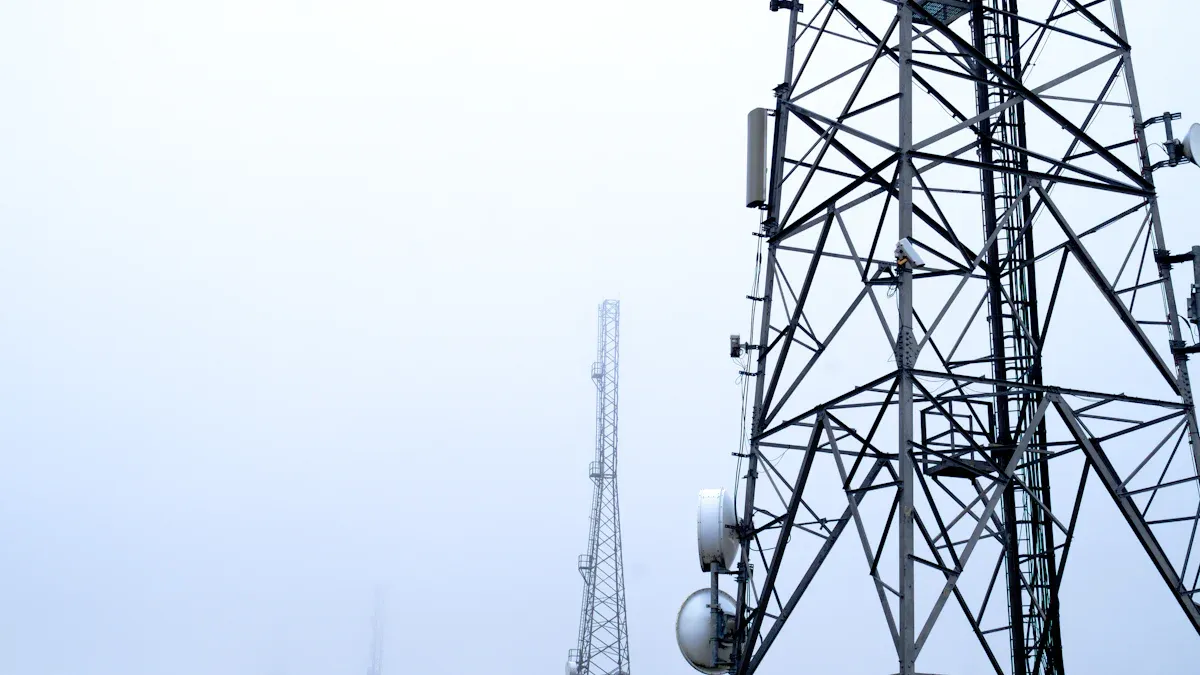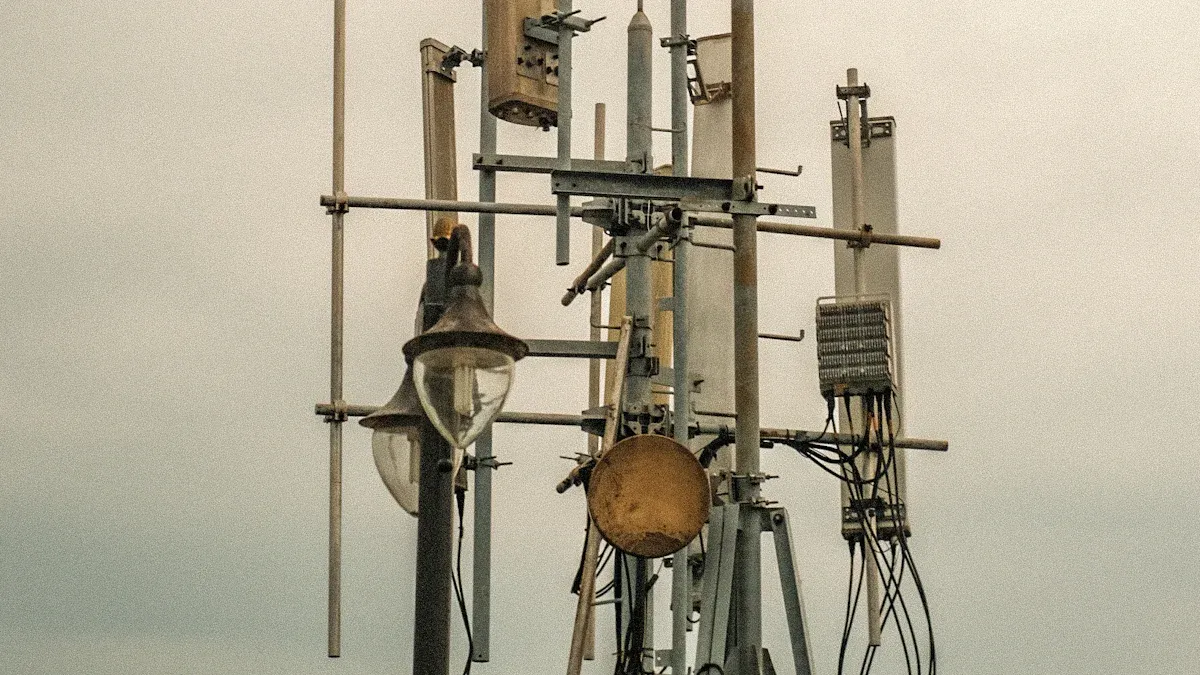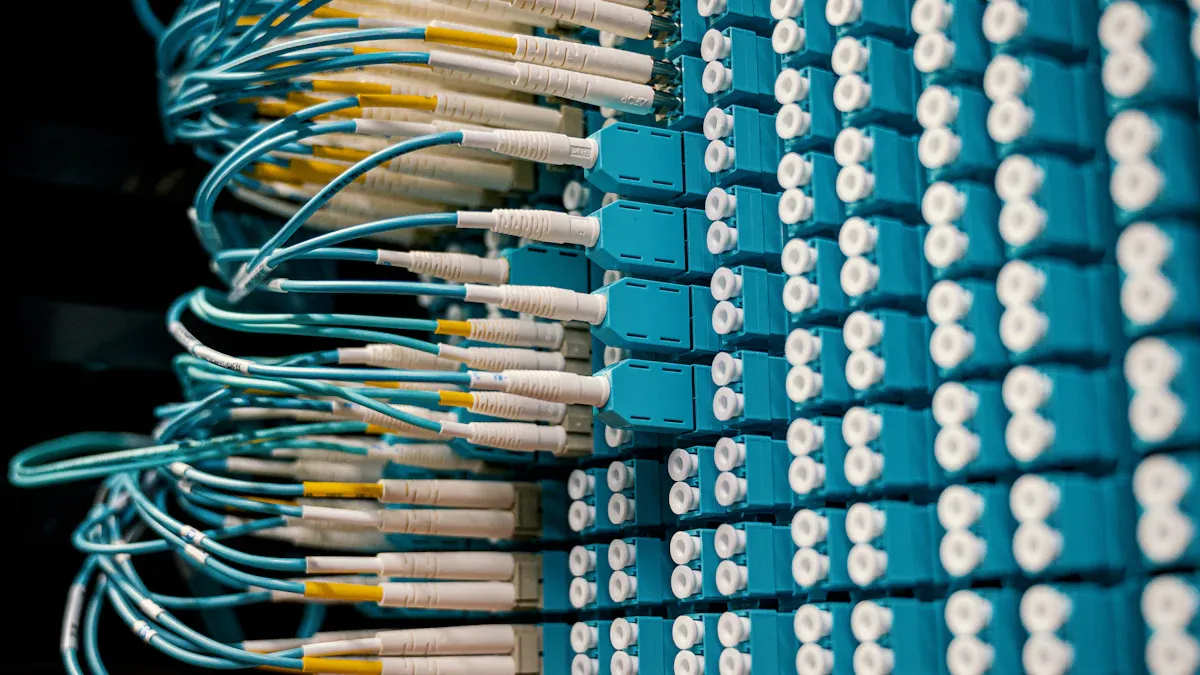Reliable Telecom Rectifier Systems for Your Power Needs

Imagine if your phone calls dropped, or your internet stopped. Annoying, right? That’s why telecom rectifier systems are so important. They help keep power steady for telecom networks. These systems change AC power into DC power. This keeps your devices and networks running without stopping.
Today, about 70% of new telecom setups use these systems. They handle the huge data needs of 5G networks. Modern rectifiers, like Class 4 ones, provide double the power for 5G. They also save energy by wasting less. With a power factor of 0.99 and 95% efficiency, they are both strong and energy-saving.
Using systems like the IPack65 saves 7.64% energy each year. This lowers costs and helps the environment. So, whether it’s better communication or helping the planet, these systems do it all.
Key Takeaways
Telecom rectifiers change AC power into DC power. This keeps devices like servers and routers running smoothly.
New rectifiers work very well, with some reaching 99% efficiency. This saves energy and helps the environment.
Picking the right rectifier means knowing your power needs. It should also work well with your current systems.
Modular rectifiers are easy to upgrade as power needs grow. They are a good choice for future changes.
Checking and monitoring rectifiers often can make them last longer. This also lowers costs over time.
Understanding Telecom Rectifier Systems

What Is a Telecom Rectifier System?
Ever think about how telecom networks work all the time? That’s thanks to a telecom rectifier system. This device changes AC power into DC power. Why is this important? Most telecom tools, like servers and routers, need DC power to work. Without a rectifier, they wouldn’t run right.
It’s like the heart of telecom power systems. It keeps your calls, texts, and internet running smoothly. New rectifiers can handle big power needs and save energy too. They’re small, strong, and last long, making them vital for telecom setups.
Role in Telecom Power Solutions
Telecom rectifiers are key to keeping networks working well. Think about a data center or telecom tower. They need steady power to support 5G and other tech. That’s what rectifiers do best.
The telecom world is growing fast, especially in places like Asia Pacific. Cities and industries there are expanding quickly. Companies are spending more on IT to keep up. For instance, the UAE’s data center market will grow 3.43% yearly until 2027. This shows how important rectifiers are for stable power in towers and centers.
But it’s not just about power. Modern rectifiers cut energy use and help the planet. Thanks to better semiconductors, they’re now smaller and more efficient. They’re great for businesses and the environment.
Key Features of Rectifier Power Systems
What makes rectifiers special? Here’s a simple list:
Efficiency: They save energy with up to 99% efficiency. This lowers electricity costs.
Power Density: They pack 73 W/in³ of power into a small size. Great for tight spaces.
Durability: They last up to 15 years. That’s long-term reliability.
Low Failure Rate: Only 1 failure in 15 years. This means fewer problems.
Flexibility: They work with loads from 30% to 100%. Perfect for different needs.
As demand for energy-saving solutions grows, telecom companies innovate more. Rectifiers are improving to meet modern power needs. Whether for small towers or big centers, they offer the reliability and performance required.
Categories of Telecom Rectifier Systems
Telecom rectifiers come in types for different power needs. Let’s look at common ones and their benefits.
48VDC Rectifier Systems
48VDC rectifiers are great for telecom and industrial DC power. They give steady power to base stations, routers, and switches.
These systems save energy and lower electricity costs. Their small size fits tight spaces easily. They work well for small towers or big data centers.
Tip: Need more power later? Add units to scale up easily.
24VDC Rectifier Systems
24VDC rectifiers are perfect for smaller setups or low-voltage tools. They’re used in remote sites or places with less power demand.
They’re affordable and simple to maintain. If you’re on a budget, they’re reliable without extra features. Businesses love them for dependable power.
110/220VDC Rectifier Systems
For bigger power needs, 110/220VDC rectifiers are ideal. They support large telecom setups and industrial systems.
These rectifiers are tough and last long. They handle high-demand environments well. They also fit smoothly into existing systems for complex setups.
380VDC Rectifier Systems
For big telecom setups, 380VDC rectifiers are a great choice. They work well in places like data centers or telecom hubs. These systems turn AC power into DC power efficiently. This keeps your equipment running without stopping.
A key feature is their ability to handle heavy loads. They also save energy while providing high-voltage power. Their small size makes them easy to fit into tight spaces. They’re perfect for large setups needing steady power.
Pro Tip: Expanding your setup? Add more units as power needs grow.
Hybrid Rectifier Systems
Hybrid rectifiers mix renewable energy, like solar, with traditional power. They’re great for remote areas or places with weak power grids. These systems give steady power and help lower your carbon footprint.
They are flexible and work in many setups. Use them for rural telecom towers or small city systems. Over time, they save money by cutting energy and maintenance costs.
Note: Choose hybrid systems if your business values sustainability.
Rectiverters in Telecom Applications
Rectiverters combine rectifier and inverter functions in one device. They let you switch between AC power and DC power easily. This makes them very flexible for different equipment needs.
These systems are ideal for setups needing both AC and DC power. They simplify your power system by reducing extra devices. They’re also energy-saving and reliable, perfect for modern telecom use.
Did You Know? Rectiverters save space and cut costs by replacing separate devices.
Top Telecom Rectifier Systems in the Market
Picking the right telecom rectifier is very important. It ensures your network gets steady power. Let’s check out three top rectifiers that are popular today.
Delta Electronics DPR 850B EnergE
The Delta Electronics DPR 850B EnergE is a strong performer. It’s made to be efficient and reliable, perfect for telecom use. With up to 96% efficiency, it saves energy and lowers carbon emissions.
Its small size is a big advantage. It fits easily into tight spaces, great for modern setups. It also handles different power needs, keeping your network running smoothly during busy times.
Did You Know? Delta Electronics is famous for its smart, energy-saving products.
BENNING TEBECHOP 13500 SE
Need a tough and advanced rectifier? The BENNING TEBECHOP 13500 SE is a solid pick. It works well in rough outdoor conditions, making it ideal for outdoor telecom sites.
This rectifier has a modular design, so you can add more units as needed. You can also monitor its performance remotely, which is super handy. With a lifespan of over 15 years, it’s a reliable long-term choice.
Pro Tip: Modular rectifiers like this one are great for growing businesses.
Vertiv NetSure 8000 Series
The Vertiv NetSure 8000 Series is a top choice for modern networks. It’s efficient and reliable, meeting today’s telecom demands. With 73 W/in³ power density, it’s powerful yet compact.
Its smart energy system manages power use, cutting costs. Plus, its strong design ensures power stays on, even in tough conditions.
Market Insight: The rectifier market is growing fast, expected to hit $12.22 billion by 2032. This shows the need for efficient power solutions like the NetSure 8000 Series.
Top Rectifier Companies |
|---|
Vishay Intertechnology, Inc. |
Semiconductor Components Industries, LLC |
Diodes Incorporated |
STMicroelectronics |
Infineon Technologies AG |
These rectifiers are just a few great options. Each has special features for different needs. Whether you want efficiency, growth options, or durability, there’s a rectifier for you.
Eltek Flatpack 2 Rectifiers
Eltek Flatpack 2 Rectifiers are loved by telecom experts. They are small, efficient, and very dependable. If you need steady power in a small space, choose these.
These rectifiers work well in busy places like data centers or towers. They keep your equipment running without problems. Their modular design lets you add more units for extra power.
They also save energy with advanced technology. This lowers electricity costs and reduces waste. Built to last, they won’t need replacing often.
Pro Tip: Short on space but need strong performance? Flatpack 2 is ideal.
Advanced Energy AC-DC Rectifiers
Advanced Energy AC-DC Rectifiers are flexible and powerful systems. They are great for setups needing both AC power and DC power. They convert power efficiently to keep networks running smoothly.
These rectifiers adapt to different environments easily. They fit well in small sites or big industrial setups. Their compact size makes installation simple in tight spots.
Smart monitoring features let you check performance remotely. This saves time and effort. They are reliable, energy-saving, and meet modern telecom needs.
Did You Know? Advanced Energy rectifiers are famous for lasting designs and smart features.
Best Plus Power Rectifier Systems
Best Plus Power Rectifier Systems balance good performance with low cost. They give steady power without being expensive.
These systems are perfect for small or medium telecom setups. They are easy to install and maintain. Even though they are affordable, they are high-quality and dependable.
You can add more units as your power needs grow. This makes them great for businesses wanting reliable power on a budget.
Note: Best Plus Power systems are ideal for startups needing affordable solutions.
Benefits of Telecom Rectifier Systems

Energy Efficiency and Cost Savings
Telecom rectifiers are designed to save energy. They use power wisely, lowering electricity bills. With 98.5% efficiency, they waste very little energy.
Here’s how they help you save money:
High efficiency means lower costs and less environmental harm.
Less heat produced cuts cooling costs by 22%.
Long-lasting systems need fewer repairs and replacements.
Metric | Value |
|---|---|
Efficiency Rate | 98.5% |
Reduction in Cooling Costs | 22% |
Operational Cost Reduction | Saves money with reliable performance |
These systems also improve reliability. They keep telecom tools working well, avoiding downtime. Investing in good rectifiers saves money and ensures stable operations.
Scalability and Flexibility in Power Systems
Telecom systems often grow as businesses expand. Rectifiers are easy to upgrade when power needs increase. You can add more units without replacing the whole system.
They work well with both small and large setups. Whether it’s a rural tower or a big data center, rectifiers adjust easily.
Tip: Modular rectifiers are great for future upgrades and growth.
Remote Monitoring and Management
You can now manage telecom power systems from anywhere. Modern rectifiers have remote monitoring tools. These let you check power use and system health in real time.
This is very helpful for managing faraway sites. It saves time and reduces the need for on-site visits. With remote monitoring, problems can be fixed quickly, keeping services running smoothly.
Did You Know? Remote monitoring lowers maintenance costs and improves system efficiency.
Enhanced Reliability and Longevity
Reliability is super important for telecom power systems. Imagine your network failing during busy hours. That would be really annoying! Telecom rectifier systems are made to last and keep things running smoothly.
These systems are tough and built to handle hard conditions. Many can work for over 15 years without big problems. They resist extreme heat, cold, and humidity. You won’t need to worry about frequent fixes or expensive repairs.
Tip: Pick rectifiers with a very low failure rate. Some models only fail once in 15 years, giving you confidence.
Another reason these systems are dependable is their ability to handle changing power needs. Whether your setup uses 30% or 100% power, rectifiers adjust easily. This keeps your network steady, even during sudden changes.
Modern rectifiers also have smart tools for tracking performance. These tools help find problems early before they get worse. You can check everything remotely, saving time and avoiding trips to the site. It’s like having a helper for your power system.
Reliability Features | Benefits |
|---|---|
Low Failure Rate | Fewer interruptions |
Long Lifespan | Lower replacement expenses |
Smart Monitoring Tools | Fast problem detection |
Flexible Load Handling | Smooth operation |
Getting a good rectifier system isn’t just about keeping things powered. It’s about making sure your network stays strong for years. If you want fewer problems and more uptime, choose a system that’s made to last.
Choosing the Right Telecom Rectifier System
Understanding Power Needs
Before picking a rectifier, know your system's power needs. Check the devices you use, like servers and routers. Each has its own power demand. Add these together to find the total power required.
Think about busy times when power use is higher. Your system should handle these peak hours without issues. Choose a rectifier with extra capacity for safety. This helps if your power needs grow later.
Tip: Add 20% more power than needed for better reliability.
Matching with Current Systems
Your rectifier must work well with your current setup. Check the voltage and current of your existing equipment. If they don’t match, it could cause problems or damage.
Also, think about space. Some rectifiers are small, while others need more room. Make sure you have enough space for installation. Compatibility means fitting into your system easily without trouble.
Pro Tip: Pick rectifiers with flexible designs for different setups.
Planning for Future Growth
Telecom systems often expand over time. Choose a rectifier that can grow with your needs. Modular systems are great because you can add units later.
Think about your future plans. If you want to expand or use new tech, pick a rectifier that supports these changes. A scalable system saves money and avoids big upgrades later.
Did You Know? Modular rectifiers are easy to upgrade and save costs.
Budget and Long-Term Cost Analysis
When picking a telecom rectifier system, think beyond the first cost. Long-term expenses can greatly affect your budget. A good system gives steady power and saves money over time.
Start by checking the price. Cheaper systems may seem better but cost more later. They might use extra energy or need frequent fixes. Spending more on a quality system avoids these hidden costs.
Energy efficiency is key. Efficient rectifiers use less power, cutting bills. For instance, systems with 98% efficiency waste very little energy. Over a year, this saves a lot of money. Less wasted energy also means less heat, lowering cooling costs.
Maintenance is important too. Some rectifiers last over 15 years with little care. Others need regular repairs, which can be pricey. Choose systems with low failure rates to avoid surprise expenses.
Scalability is also helpful. Modular rectifiers let you add units as power needs grow. This avoids buying a whole new system when expanding. It’s a smart way to save money for the future.
Tip: Compare the total cost of ownership (TCO) for systems. This includes price, energy use, repairs, and lifespan. Spending more upfront can mean saving more later.
By balancing costs now and later, you can pick a system that fits your needs and budget.
Telecom rectifier systems are key for keeping networks powered. They make sure your devices and tools work, even during busy times. Picking the right system can lower costs, boost efficiency, and last a long time.
The need for better systems is growing fast. With 5G and mobile networks expanding, strong connections are more important than ever. Good systems stop downtime and protect data, making them a must for businesses.
Why choose top-quality systems?
The telecom market is growing, reaching $12.49 billion by 2030.
New tech like 5G needs strong and flexible power systems.
Reliable systems cut repair costs and help the environment.
🌟 Tip: Buy a high-quality telecom rectifier system now to keep your network ready and efficient for the future.
FAQ
How long do telecom rectifiers last?
Telecom rectifiers usually work for 10 to 15 years. Their lifespan depends on how well they are made and cared for. Regular maintenance can help them last longer and keep your network powered.
How can I pick the right rectifier system?
First, figure out how much power you need. Check your current devices and think about future upgrades. Pick a system that fits your voltage needs and can grow with you. Modular systems are great for easy expansion.
Do rectifiers work during power outages?
Yes, they do! Many rectifiers connect to backup systems like batteries or generators. This keeps your network running when the power goes out. Choose models that switch smoothly to backup power for no interruptions.
Are hybrid rectifiers a good choice?
Yes, they are! Hybrid rectifiers use renewable energy, like solar, along with regular power. They save money and help the planet. If you work in remote areas or care about the environment, hybrid systems are a great option.
How often should rectifiers be serviced?
You should check your rectifiers once a year. Regular maintenance finds problems early and keeps them working well. Some systems have remote tools to spot issues, saving time and effort.
See Also
Ensuring Consistent Power Supply For Telecom Equipment
Essential Insights Into Telecom Power Supply Characteristics
Calculating Power Systems And Battery Needs For Telecom Cabinets
Integrating Solar Inverters And Batteries In Telecom Cabinets
CALL US DIRECTLY
86-13752765943
3A-8, SHUIWAN 1979 SQUARE (PHASE II), NO.111, TAIZI ROAD,SHUIWAN COMMUNITY, ZHAOSHANG STREET, NANSHAN DISTRICT, SHENZHEN, GUANGDONG, CHINA

